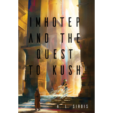As a big fan of Al Sirois’s novel Murder in Mennefer, an absorbing and briskly paced coming-of-age story set in ancient Egypt, I was delighted to learn of a forthcoming sequel to it: Imhotep and the Quest to Kush. Like its predecessor, this new novel immerses us in the adventures and travails of an intellectually curious young man, Imhotep, who has developed a special interest in herbs and spells that can heal or improve the health of the sick. Imhotep’s interests and abilities bring him into the orbit of the politically powerful and those acting against them, which at times puts him in grave danger. In Imhotep and the Quest to Kush, challenges and dangers introduced in the first novel ratchet up to more perilous heights, creating an engrossing and suspenseful reading experience.
(As an aside, you don’t have to have read Murder in Mennefer to understand or enjoy Imhotep and the Quest to Kush. That said, for the fullest and most rewarding experience, I recommend that you read Murder in Mennefer first, if possible. For more details on that book, check out my review of it.)
The “quest” in the title of the new book refers to Imhotep’s central mission in these pages: to travel to Kush, a region far south of his home in Mennefer (a.k.a., Memphis, once the capital of Egypt), to learn more about healing plants and practices. This mission takes on new urgency when Imhotep learns that Egypt’s king, Sanakhe, is gravely ill. (Although the king’s condition is never named, he appears to be suffering from dementia, and perhaps from the fallout of a stroke.) With the urging of the king’s brother, Prince Djoser, Imhotep sets his sights on bringing new healing measures back from his travels before it’s too late, and he begins to travel south by boat.
However, Imhotep does not make the decision to leave Mennefer lightly. For one thing, his family is in tough financial straits following the death of his father, an architect and builder whose business is now being run (somewhat reluctantly) by Imhotep’s brother. For another, Imhotep knows he will deeply miss a young woman he’s fallen in love with, the daughter of a local baker.
During the journey to and from Kush, Imhotep’s healing powers–and survival strategies–are put to multiple tests. For example, when one of the sailors on a boat he’s traveling on is seriously injured by a hippopotamus, Imhotep must bring his healing abilities into service, smartly using various tools at his disposal, such as marsh grass to stitch the sailor’s wound closed and honey to prevent infection. (The detailed descriptions of Imhotep’s healing methods and of his day-to-day activities, such as helping to crew the boats he travels on, are one of the great pleasures of the book.)
In terms of survival strategies, Imhotep must remain on constant guard in the face of several potential threats he encounters during his travels. One possible threat is the king’s physician, who accompanies Imhotep through much of his journey. An insecure and condescending fellow, the physician sees Imhotep as a serious rival. Then there’s the physician’s niece, who seems to be pursuing Imhotep romantically but who may also have another, darker agenda. Perhaps most dangerous are members of the Sons of Atum, who were introduced in Murder in Mennefer. Unlike Imhotep, the Sons are far from allies of the king. They believe that Sanakhe stole land that was rightfully theirs, among other crimes, and that he and those supporting him, including Imhotep, must be brought down for these wrongs. A challenge for Imhotep is that members of the Sons of Atum appear to operate under cover, and they seem to have him constantly in their sights, even as he travels from location to location. Not wanting to give away too much, I don’t want to reveal where, exactly, Imhotep’s journey leads him, literally and metaphorically. I will say that his encounters with various threats and obstacles create a suspenseful adventure story with some intriguing twists–and, at times, with Imhotep getting otherworldly help from mythical figures of ancient Egypt. Furthermore, in Imhotep, Sirois has created a character we want to root for–a young man whose thoughtfulness and compassion equal his intelligence.
I also appreciate how Sirois weaves ancient-Egyptian history into the novel. As mentioned in my review of the previous novel, there was an actual, historical Imhotep. He was a “vizier, sage, architect, astrologer, and chief minister to [King] Djoser (reigned 2630–2611 BCE), who was later worshiped as the god of medicine in Egypt and in Greece, where he was identified with the Greek god of medicine, Asclepius.” As an architect, Imhotep seems to have invented the step pyramid we know today. At one point in Imhotep and the Quest to Kush, it appears that Imhotep mentioned the idea of such a pyramid to then-Prince Djoser, and Djoser says he would like to see such a structure built.
Although the book can be described as a young-adult novel, it should appeal to adventure-story fans of all ages, and to anyone interested in what life was like in ancient Egypt, not just for the wealthy and powerful but also for everyday people. It is a pleasure to recommend this novel, and if Imhotep’s adventures continue in yet another book, I will look forward to reading it.
Would My Pick be Your Pick?
If you're interested in ________, the answer may be "Yes":■ Historical fiction, especially stories of ancient Egypt
■ Young-adult fiction
■ Adventure stories
■ Details about life in ancient Egypt

